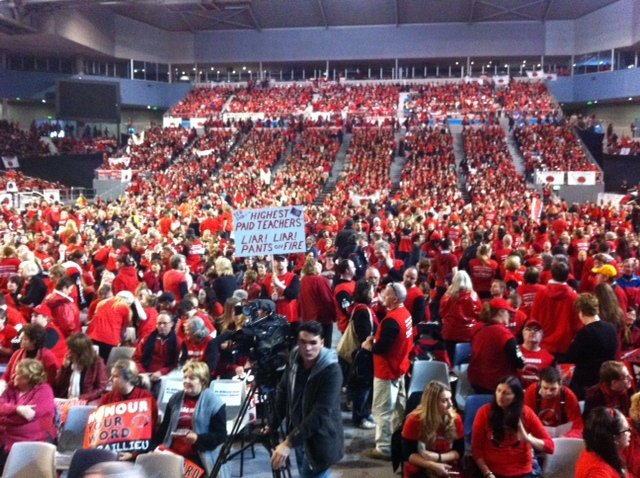
Up to 30,000 Victorian school teachers took strike action on June 7 in what the Australian Education Union (AEU) said was the largest teachers’ strike in the state’s history. More than 11,000 — many wearing the AEU signature red colours — marched through the streets of Melbourne to rally at state parliament.
Before the march, teachers packed out Melbourne’s Hisense Arena for a mass meeting. Several hundred more people who could not fit in gathered outside to watch and listen to the proceedings on huge screens.
Many hundreds of teachers also attended regional meetings in Mildura and Wodonga. They connected with the Melbourne rally via a live stream.
AEU Victorian president Mary Bluett said more than 150 schools had closed as teachers walked off the job.
Bluett said teachers were prepared for a long campaign of rolling industrial action. She warned the Ted Baillieu Coalition government that more strikes would take place in term three if the government refused to negotiate in good faith.
One of the government proposals most concerning teachers is performance pay, which teachers say would worsen student outcomes. They also say performance pay ignores the fact teaching is a collaborative profession.
Bluett told the cheering crowd: “You reject it, it won’t happen — nadda, never. Teachers get the best outcomes when they are working together, not competing against each other.”
Minister for the Teaching Profession Peter Hall said 30% of teachers would be paid more than their interstate colleagues under the performance pay plan. This would leave 70% of teachers without a just and deserved pay rise.
Luke Sinclair, a contract teacher from Princes Hill Secondary College, told News.com.au that his lack of job security was a big problem.
He said: “I want to stay teaching. I really, really love being a teacher, but it makes it really, really hard for me to stay in the profession when every six months I’m reapplying for a job,” he told reporters.
“I’ve got a five-year-old and a two-year-old and I want to keep a roof over their heads.”
Hall told News.com.au that short-term contract teachers were needed to cover leave for permanent staff.
But this ignores the fact the numbers of teachers on short-term contracts has varied across states in past years, reflecting state government policy and objectives at the time.
Also, giving more teachers permanent work cuts class sizes, but this requires government investment, something Hall is not interested in.
Pleasant St Primary School teacher Allyson Hankin told News.com.au at the rally: “It’s not about the money for me because I'm at the end of my career, but I really object to the number of teachers on contracts.”
AEU officials presented the stopwork meeting with a resolution for “a range of bans and limitations to be implemented strategically throughout the campaign to escalate the dispute” and “a further program of stopworks of between one and 24 hours at a state-wide, regional and sub-branch level”.
The rally gave a huge boost to teachers’ morale. It spectacularly put the campaign in the public spotlight and placed huge political pressure on the Baillieu government.
The Teachers & ES Alliance made up of classroom teachers, put forward an amendment to strengthen the campaign, calling for a further 24-hour mass stopwork meeting in the first month of term three.
They moved this amendment because they believe that the AEU membership must be actively involved in the campaign and regularly consulted about the direction of the campaign. Many teachers were receptive to these arguments.
AEU Victorian branch secretary Brian Henderson spoke against the amendment, but conceded the need for more stopwork meetings. The amendment was lost, but the AEU officials promised an even bigger stopwork action in the future.
The ingredients for a successful campaign include further stopwork action, mass rallies and membership control of the campaign. The AEU has the chance to lead a successful campaign because teachers have clearly demonstrated their commitment and determination to win.